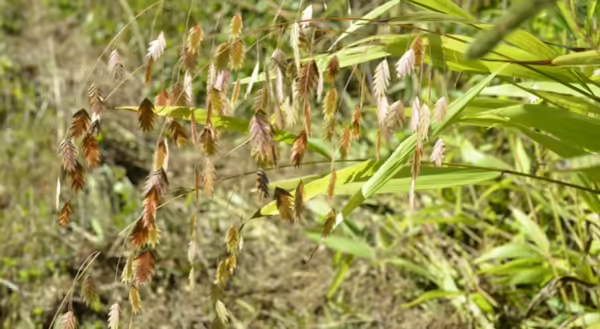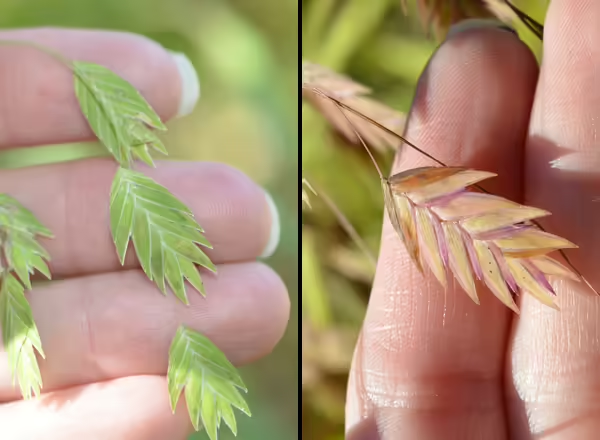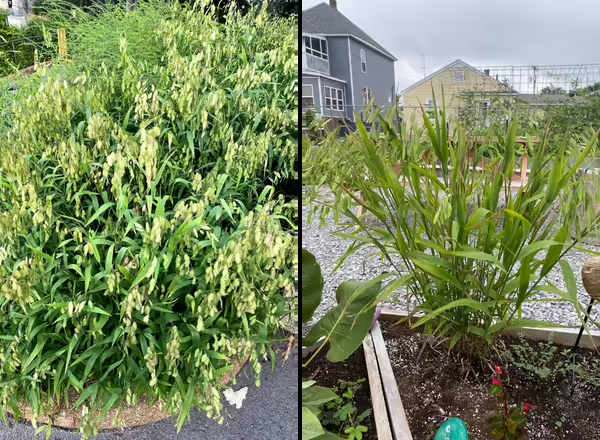
Today while visiting one of the food donation gardens I manage, I stopped by our sensory garden to see what was blooming. Finding plants for a sound garden is challenging, but we added in some native grasses, as they create a pleasant rustling sound when a breeze flows through the leaves. The grass we chose to add is River Oats, Chasmanthium latifolium. I was happy to see it in bloom today.
River Oats is one of those grasses that has numerous common names, also called Inland Sea Oats or Wild Oats. I’ve seen this grass growing in bottomland forests, on the edges of lakes, in full sun, and increasingly planted ornamentally. This grass is very adaptable to different growing conditions. You can find it naturally occurring in the southern half of Illinois.

Vegetative traits
Once you learn its characteristics, this grass will stand out from the crowd. It usually grows between 2 and 4 feet tall. Its leaves are rather broad, up to an inch across in width. They remain broad and then taper sharply to a point. There is a ligule, and it is made up of short hairs.
When the new growth emerges in the spring, I like to look for bright green, broad leaves, but I also use my context clues. Last year’s inflorescence usually remains into the spring, so look for tan, flattened spikelets held on stems above the fresh leaves.

Unique spikelets
The panicle produced by this grass droops, and the spikelets are very unique. They are extremely flat, oat-like spikelets. They rustle pleasantly in the wind. Starting out green, they will turn golden with age in the fall, one of the reasons this grass is used in landscaping.

Cultivation tips
A word of caution – this grass spreads through rhizomes and can be aggressive. It will also reseed itself. I’ve seen some stunning landscaping of this grass at zoos with strongly edged planters. Keep in mind that if you want this grass in your landscaping, it might be a good idea to separate it off from other areas of your garden. We placed it in a separate raised bed in our sensory garden.
Have you seen River Oats before?
Never miss a new post! Sign up for our email list.
ABOUT THE AUTHOR: Erin Garrett is a Natural Resources, Environment, and Energy Educator for University of Illinois Extension serving Alexander, Johnson, Massac, Pulaski, and Union counties. Erin develops and delivers high impact programming to adults and youth to help them develop an appreciation for natural resources and to empower them to make small changes to positively impact the environment. Erin’s programming focuses on why homeowners should consider choosing native plants, how to support native pollinators, how to identify grasses, how to identify and manage invasive species, and developing an appreciation for prairie ecosystems.
ABOUT THE BLOG: Grasses at a Glance dives into grass identification, focusing on tips and tricks that make grass identification possible. Get information about native and non-native species, how to tell look-alikes apart, and which grasses you can find in Illinois.
River Oats, Chasmanthium latifolium, is a native, cool season grass found in moist woods and along streams in large colonies. It is also a popular landscape grass. It typically grows two to four feet tall and it has wide leaf blades that taper to a point. There is also a short hairy...